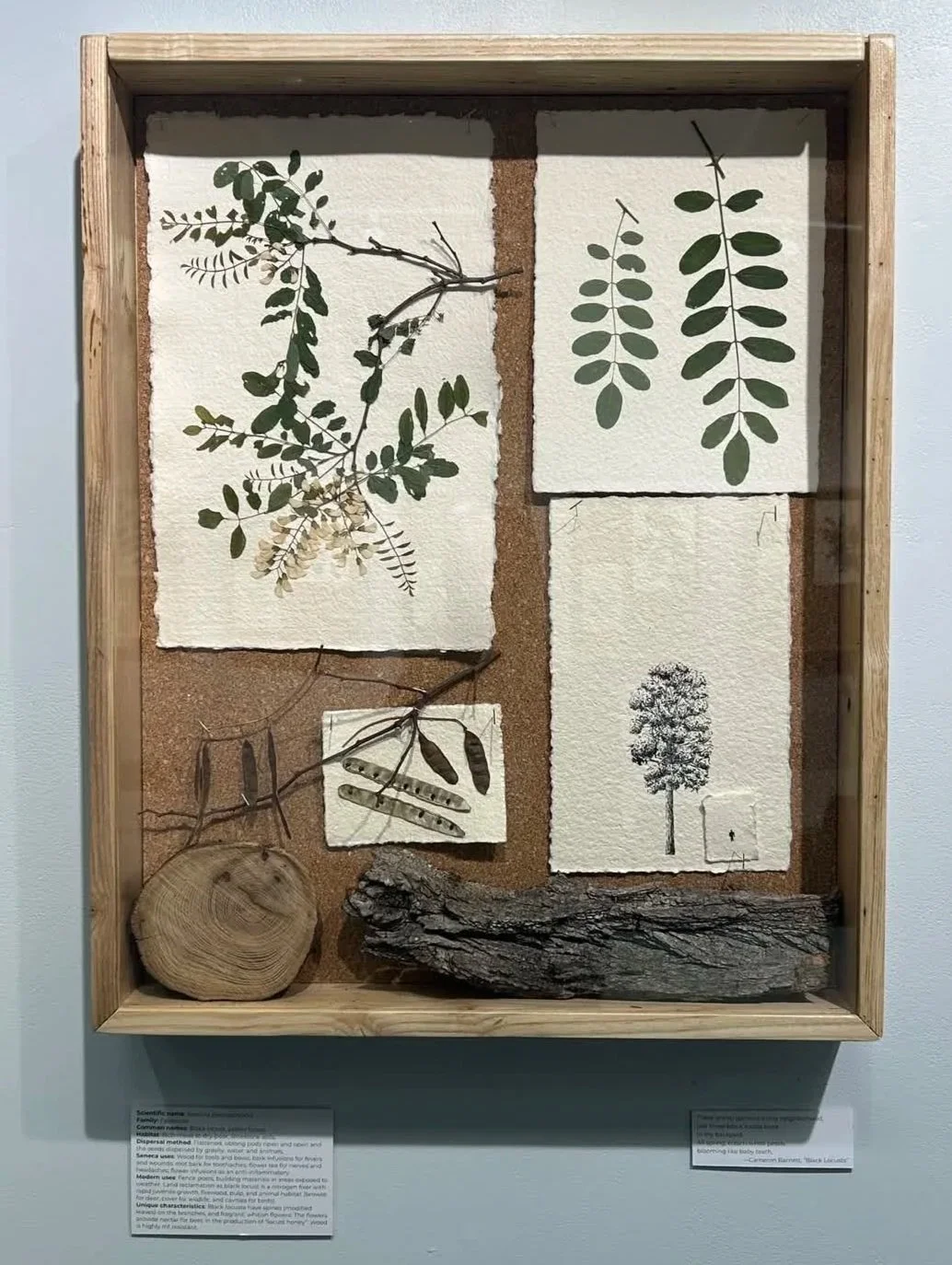Check out the Native Trees Exhibit in the Macvittie College Union!
Photo courtesy of Knight’s Life Editor Daisy Sheldon
This is one of the 24 display cases in the MacVittie Ballroom Lounge; it features the native black locust tree, which disperses long pods to reproduce.
Beginning on Oct. 30, 2025, an interesting display took up residence in the MacVittie College Union Ballroom Lounge: the Native Trees of the Genesee Valley Exhibit. The exhibit resulted from the collaboration of numerous faculty, staff, and students. Specifically, this initiative is the combined effort of James Kernan (Department chair of Geography & Sustainability Studies), Dan DeZarn (Director of the office of Sustainability), Brian Hoven (Assistant Professor of Biology), Lytton Smith (Professor of English), Alessandra Otero Ramos (Milne Library’s Liaison Librarian to Arts and Humanities) alongside Mark Moroz (A senior Biology and Mathematic major) and various students from the SUST 336: Sustainability and Environmental Stewardship course.
There are 24 native trees on display, each with its own case mounted to the wall. The cases include branches, leaves, berries, bark, tree “cookies,” or other bits and pieces relevant to the particular tree, with each case artfully designed to show the makings of a native tree. Additionally, each case features sketches of the tree in question, accompanied by a drawing of a miniature human figure done by senior Mark Moroz. The frames of the cases themselves came from a singular tree species: ash trees. As advocates of sustainability, the wood was salvaged from dead ash trees—killed by the invasive emerald ash borer—through the SUNY Geneseo Teaching and Learning Center (TLC) Innovation Grant.
There are also two placards under each case. One placard details the scientific name, family, common names, habitat, seed dispersal method, Seneca Nation uses for said tree, modern uses, and unique characteristics. According to a blurb at the entrance, the other placards under each case are quotes from various literary works that “highlight the deep connections between people and trees” sourced by English professor Lytton Smith. Other signs around the room provide insight into invasive insects threatening native trees, evolutionary anachronisms, Oak Savannas, and the long-standing Genesee Oaks which witnessed the settlers James and William Wadsworth. If you want to know which tree is what, you can peruse the gallery and discover for yourself the history of the trees!
Many trees in the exhibit have names most have probably heard of or could recognize, such as maple, oak, and elm. However, other displays include lesser-known species like the black locust, juneberry, tulip poplar, and larch. One beautiful example of the literary work presented with each tree references the sycamore. The literary excerpt for this tree comes from Kathy Fagan’s “Tactile Sycamore” and reads, “Sycamore. Sick amour. Seek no more. Skip to / my lou. My skin. My bark. My blight is / not worse than my bite.”
The exhibit includes artwork by Alessandra Otero Ramos, a librarian at Milne Library. Making naturally pigmented inks from plants and trees, her artwork, “Autumn Leaves,” uses inks from and leaves of five different trees. Alongside the artwork are the individual inks displayed on paper with the name of the tree they originated from.
The overall message the exhibit conveys is one of awe at the natural beauty surrounding us and the importance of the ecosystem historically and today; as the introductory sign says, trees are our “vital companions.” The sign also informs the viewer that “[e]ach featured species holds practical, cultural, and sometimes spiritual significance for the people of the Seneca Nation, members of the Haudenosaunee Confederacy, who were stewards of this land long before us.” Hence, each sign under the cases mentions not only modern uses, but also the Seneca peoples’ historical uses.
Tree diversity is just as important today, though mostly for different reasons. Now more than ever the world is facing climate change that threatens biodiversity and natural life—including our own. Trees, which are consumers of carbon dioxide, are negatively impacted by deforestation and thus cannot aid in the alleviation of global warming. Also worth noting is that ecosystems are not separate from human life, but rather benefit humans, with a “mature urban tree provid[ing] $100 - $500 in ecosystem services per year,” as explained by another sign.
The exhibit is a worthwhile experience, not only for its beauty but for the important information it conveys, and will be up until the end of the semester. The next time you are in the Union, be sure to stop by, look around, and read through the various aspects of the exhibit to gain an appreciation of the natural world surrounding you and its importance!

